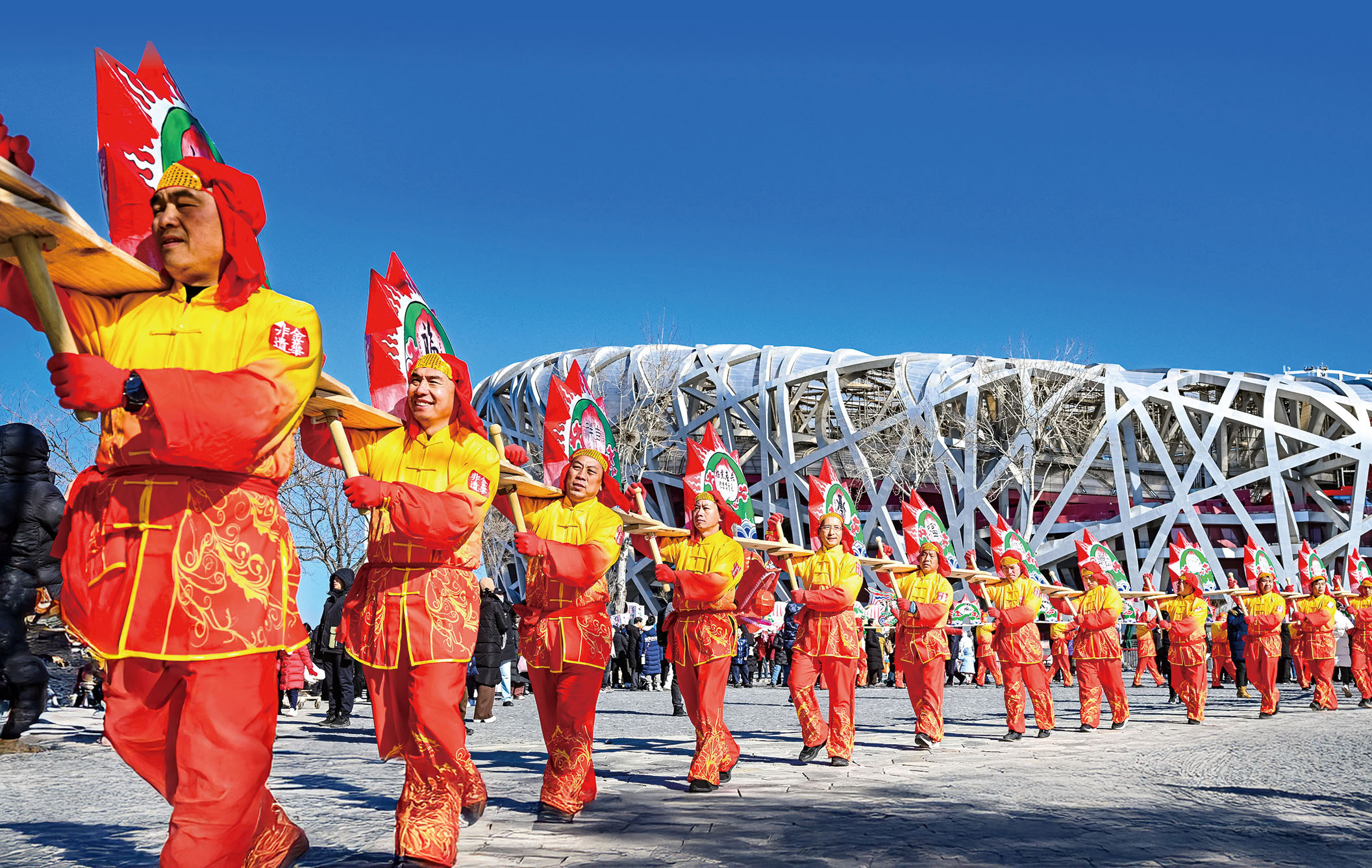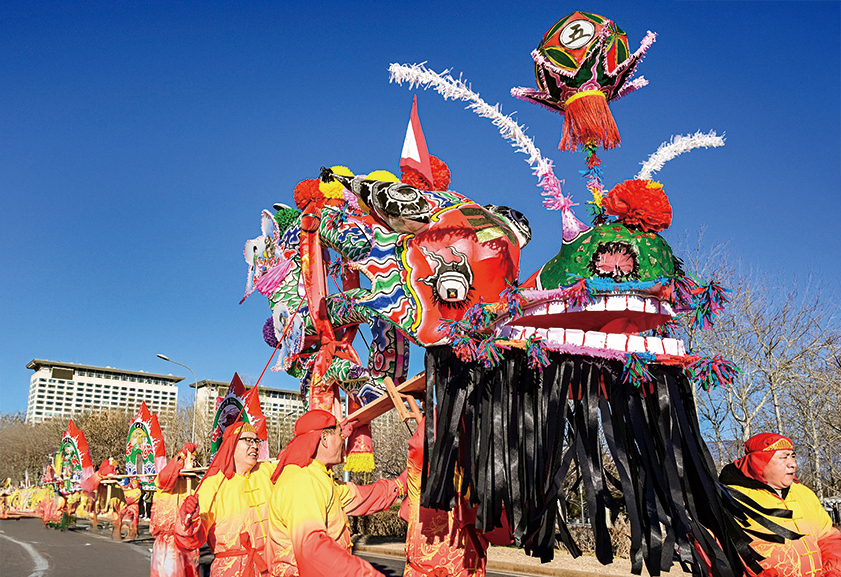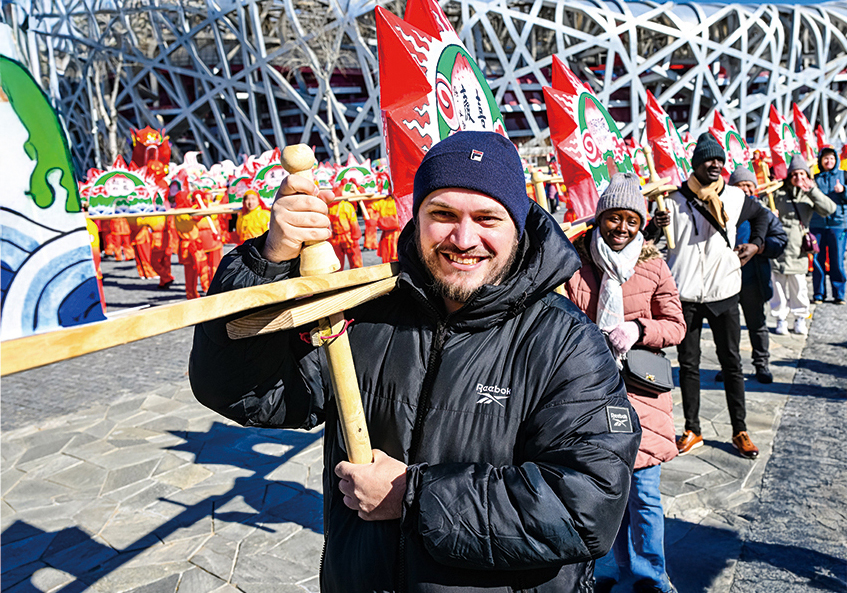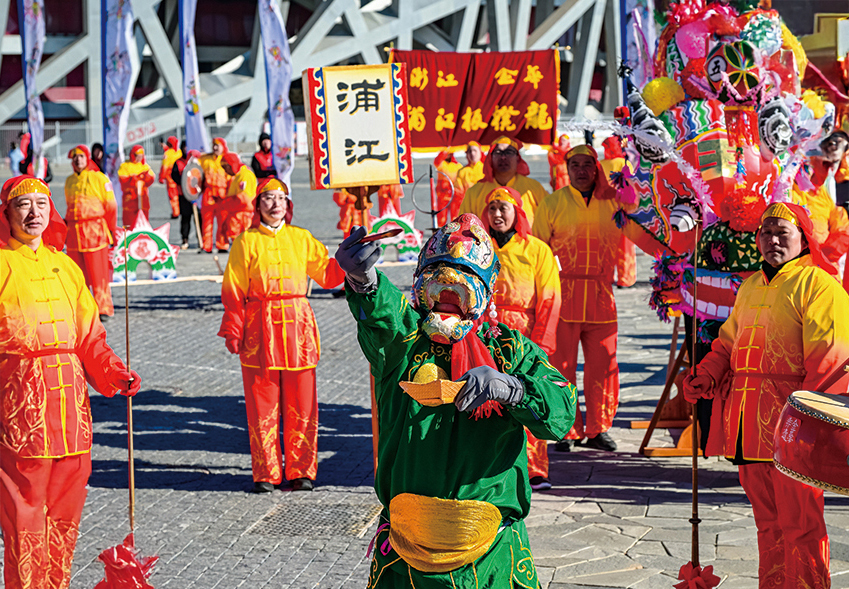The Pujiang bench dragon, a dazzling traditional lantern performance, wows audiences at Beijing's Lantern Festival.

On Feb 12, during the Lantern Festival, a stunning giant dragon lantern, stretching over 120 meters, wound its way along Beijing's Central Axis, passing iconic landmarks such as the Bird's Nest stadium and the Water Cube.
This grand parade was led by a bench dragon performance team from Pujiang county, Jinhua, Zhejiang province.
To celebrate the Chinese New Year, the Museum of the Communist Party of China and the China National Arts and Crafts Museum invited 10 intangible cultural heritage projects from across the country to perform in Beijing. The Pujiang bench dragon, chosen as the finale act, captivated audiences with multiple performances on Feb 11 and 12.
Among the 129 bench dragon performers, 19-year-old Zhang Xiang stood out as the youngest.
READ MORE: Spring Festival, the bond of Chinese
A first-year accounting student at a university in Hangzhou, Zhejiang, this event marked his first time performing the bench dragon outside his home province.
"I'm deeply honored to showcase my hometown's intangible cultural heritage in the capital," he said. "This performance allows us to share the united, courageous, and optimistic spirit of Pujiang with audiences across China and the world."

The bench dragon has been one of the grandest traditional folk cultural activities in Pujiang since the Tang and Song dynasties (618-1279).
During the Spring Festival, each household in local villages crafts a section of the dragon's body using a wooden bench, attaching a lantern to the top. These sections are then connected, forming a long, impressive dragon lantern.
The Pujiang bench dragon is a rich and multifaceted art form that seamlessly blends calligraphy, painting, paper-cutting, bamboo weaving, and root carving with elements of sport, acrobatics, and dance.
The bench dragon brought to Beijing is particularly impressive in scale, featuring a massive 3.5-meter-long, 2.3-meter-high dragon head, a tail, and 66 sub-lanterns forming its body.
According to the Pujiang County Bureau of Culture, Radio, Television, Tourism, and Sports, 22 calligraphers and painters contributed to the dragon's design. One side of each lantern displays exquisite calligraphy, while the other is adorned with vibrant paintings.
The performance was a spectacle, involving over 70 dragon dancers, a ceremonial guard group, and a variety show team. The guards ushered in the dragon with large dragon and tiger flags, while the variety show team created a lively, festive atmosphere with the sounds of traditional gongs, drums, and suona (a double-reed woodwind instrument).

Emotional bond
In December of last year, "Spring Festival, social practices of the Chinese people in celebration of traditional New Year" was officially inscribed on UNESCO's Intangible Cultural Heritage of Humanity list, with the Pujiang bench dragon being one of its representative traditions.
For residents of Pujiang and Chinese communities worldwide, the Spring Festival is more than just a holiday — it is an emotional and memory bond, a vivid expression of their cultural identity and heritage.
For Zhang, his most cherished childhood memory of the festival was walking hand in hand with his parents to watch the bench dragon performances on the streets.
As he recalls, each village and town would organize bench dragon parades, with spectators lining the streets in anticipation. Many performances took place at night, with candles illuminating the dragon's painted body, creating an enchanting spectacle.
One of the most exhilarating and visually striking elements of the performance is "swinging the tail". As the dragon's head gracefully turns, the tail can extend as far as four or five meters, requiring strong young performers to skillfully control its movement.
The dragon's head, which leads the direction and route of the entire performance, is typically handled by experienced performers.
"When the dragon sways and rotates, the tail moves with incredible power and agility, symbolizing our ability to overcome obstacles in the New Year and move forward with courage," Zhang explained, highlighting the remarkable skill and profound meaning embodied in the performance.

A living tradition
The bench dragon is not just a heritage artifact displayed in museums — it is woven into the fabric of daily life in Pujiang.
Although Zhang had never participated in a bench dragon performance before training for this event, he felt a deep connection to the tradition. When he saw the recruitment notice, he signed up without hesitation.
Like Zhang, the other performers come from diverse backgrounds in Pujiang. They trained and rehearsed for a month under the guidance of seasoned veterans.
Before traveling to Beijing, they had already performed multiple times in Pujiang and Hangzhou and visited the local intangible cultural heritage museum to witness firsthand the intricate process of creating a bench dragon.
ALSO READ: Red blankets of joy
The tradition also holds strong appeal for young people. Among those traveling to Beijing for the performance, more than 20 were born after 1995.
According to Zhang, many of his childhood classmates and friends shared live broadcasts of bench dragon performances on social media during the Spring Festival, either as spectators or participants in local events.
The art form is also evolving in creative ways. On Feb 11, a unique water-land bench dragon show took place in Pujiang's Shanghe village. Performers carried a dragon on bamboo rafts along the Huyuan River, the mother river of Pujiang, while another dragon paraded along the riverbank. The two dragons moved in unison, presenting a stunning display.
"It brings me great joy to see this intangible cultural heritage continually infused with fresh energy," Zhang said. "I also hope that Pujiang's bench dragon will flourish, expanding beyond Zhejiang, beyond China, and onto the global stage."


